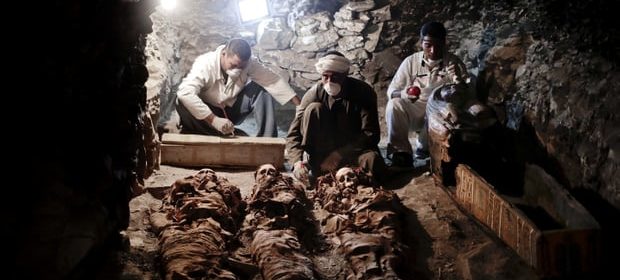Archaeologist uncovered Ancient Egyptian treasures in a tomb near Valley of the Kings

Mummies, jewels and sarcophagi are among the 3,500-year-old treasures discovered in a goldsmith’s tomb in necropolis:

A remarkable ancient Egyptian tomb has been found in the necropolis of Draa el-Naga, near Egypt’s famous Valley of the Kings.
The tomb consists of a little room at ground level and a burial chamber eight metres below containing four mummies. Its important occupant was a goldsmith named Amenemhat from the 18th Dynasty (1550BC to 1292BC), the time of Tutankhamun, Nefertiti and Hatshepsut.
The tomb also contains skeletons, funerary artefacts, including 150 ushabti statues, intended to be servants in the afterlife, and 4 wooden sarcophagi, jewellery and funerary cones.
According to Zahi Hawass, one of the world’s leading Egyptologists and Egypt’s former minister of antiquities, the discovery of a tomb containing an identifiable noble man such as this could be of great significance.
Of the 50 funerary cones found, 40 belong to 4 other officials from the period whose bodies have not yet been found. “This is a very good sign,” said Mostafa Waziry, who is leading the excavation. “It means if we keep digging in this area we are going to find four more tombs.”
The find was hailed by the present Egyptian minister of antiquities, Khaled Alnani, as “an important scientific Found”.

The tomb was reused during the beginning of the 3rd Intermediate Period (1070BC to 664BC) and another shaft was discovered nearby with 3 mummies in two coffins from the Middle Kingdom (2050BC to 1800BC).
Alnani said that this means there are a Various number of mummies to be analysed and researched, as well as sarcophagi, artefacts and poetry. “It has significance in all fields,” said Alnani.
The excavation of the region began with the discovery of the tomb of a judge a few months ago. Alnani expects to make further discoveries. “The work isn’t finished,” he said. “We hope to be making a new announcement next month.”
There have been a series of finds in 2017, which Alnani has called “a year of archaeological discoveries”. Headlines were made in March when an 8-metre quartzite statue of Psamtek I was unearthed and initially mistaken for the famous pharaoh Ramses II.
The statue of the late period king was Discovered in the crowded east Cairo suburb of Mataria, not far from Ain Shams University.
“Modern Egypt is built on top of ancient Egypt,” said Hawass. “Sometimes you excavate in your courtyard like in Aswan or Heliopolis and discover monuments.” He added: “Until now we have only found 30% of the Egyptian monuments; 70% is still buried.”

Other discoveries include a Roman-period tomb, revealed last month near the Upper Egyptian town of Minya, and more than 1,000 wooden funerary statues that were found in a 3,500-year old tomb near Luxor. In April a pyramid was Found at the Dahshur necropolis.
The recent discoveries come after a stagnant period for archaeology in Egypt, following the Arab spring protests in 2011 and subsequent drop in tourism, as visitors stayed away due to fear of terrorism and political instability.
Last year 4.8 million people visited Egypt, less than a 33% of the number for 2010. Tourism figures plummeted during the protests that toppled former president Hosni Mubarak, and were further hit by the bombing of a Russian passenger jet in October 2015, which killed all 224 on board.
Tourism to cultural sites along the Nile valley has been worst hit, with the Antiquities Ministry reporting in 2014 that income from ancient monuments had declined by 95%.
The Egyptian government has made a huge effort to get visitor numbers backto pre-2011 levels, last year hiring a New York-based PR firm to run a multimillion dollar advertising campaign to boost tourism. So far, such efforts are yet to yield much enhancement.
The loss of income has left the ministry struggling to pay for much-needed maintenance projects. “You need to maintain these landmarks,” said Hawass.
“I used to spend 1.3bn Egyptian pounds a year in the construction of museums and restoring the landmarks. You don’t have this money now and the ministry is in a very critical condition.”
Other big projects in need of funds include the Grand Egyptian Museum, still under development at the Giza plateau. The museum, which Hawass calls “the most important cultural project of the 21st century”, is years overdue and its total cost is currently estimated at $1bn (£750m), millions over budget.